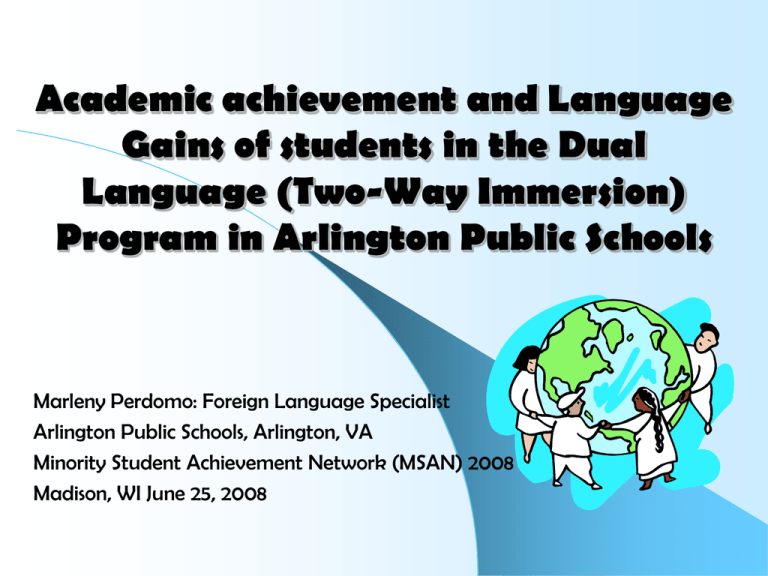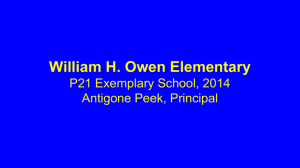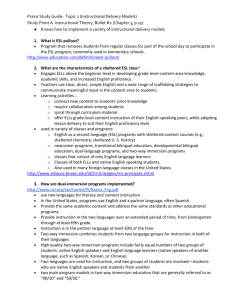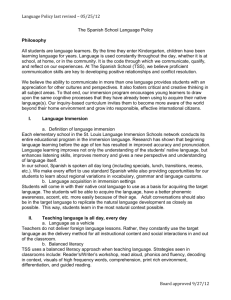Developing and Implementing a TWI Program
advertisement

Academic achievement and Language Gains of students in the Dual Language (Two-Way Immersion) Program in Arlington Public Schools Marleny Perdomo: Foreign Language Specialist Arlington Public Schools, Arlington, VA Minority Student Achievement Network (MSAN) 2008 Madison, WI June 25, 2008 Ser bilingüe abre nuevos mundos Being bilingual opens you to new worlds Defining Two-Way Immersion Education Two-way immersion (TWI) programs integrate language minority and language majority students for all or most of the day, and provide content instruction and literacy instruction to all students in both languages. Immersion schools offer more than just two languages ….we want to develop each child’s full potential, a lifelong love of learning, fluency in both Spanish and English, and an appreciation for the global community. Growth of Two-Way Immersion Education Possible Motivations for the Growth of Two-Way Immersion Education Documented success of the model through large-scale research projects (Lindholm-Leary, 2001; Thomas & Collier, 1997, 2002) and several small-scale studies (e.g., Cazabon, Nicoladis & Lambert, 1998) 2. Low academic performance and high drop-out rate among Hispanic students in the United States 3. Global economy—increasing interest in developing multilingualism and multiculturalism in the United States 1. Benefits of Bilingualism Positive effect on intellectual growth Enriches mental development More flexibility in thinking Greater sensitivity to language Develop better listening skills for learning other languages Improves understanding of native language Chance to communicate with others Understand and appreciate others Job opportunities (CAL) Common Misconceptions about Bilingualism All bilingual programs are effective If the school program is not rich and challenging – the benefit may be minimal Raising bilingual kids delays all language acquisition In the early years, it may result in slightly delayed verbal abilities Bilingualism happens at school The decision to raise a bilingual/multilingual child is a life long commitment Students with severe mental retardation may not benefit from bilingual education Dual Language Programs Criteria for Success-Overview -Kathryn Lyndholm-Leary Focus on instruction Quality language curriculum Amount of language use Additive bilingual environment Maintaining classroom balance Positive classroom interaction-best practices Qualified personnel Home-school collaboration Effective communication among stakeholders Established evaluation process Arlington Public Schools (APS) Two-Way Immersion Program Overview Total student population in Arlington: 18,779 students Total Immersion Population: 1,209 students Two elementary, one middle, one high school Immersion Program coordinated through Foreign Language Office APS TWI Program Design Two-Way Program Model Balanced groups of students: Spanishdominant and English-dominant 50% of instructional time dedicated to each language Literacy instruction in each language is provided APS- Program Design, Continued Kinder-5th grade 50% of the “academic day” in Spanish Specials (art, music, & PE) in English & Spanish 50/50 make up of students in each class Spanish: Math, Science & Spanish Language Arts English: Social Studies & English Language Arts Grades 6-8 3 class periods in Spanish (Spanish, Science, Social Studies) High School Spanish courses (I and II) specifically designed for Immersion students IB and Fluent Speakers courses are alternatives APS-TWI Program Entrance criteria None – based on where student lives After 2nd grade, English-only speakers admitted if they meet specific language proficiency criteria Kindergarten is based on lottery, but priority categories exist Francis Scott Key Elementary School Started as program within school in 1986 Key became an all-Immersion school in September of 1995 Principal: Marjorie L. Myers Total student population: 591 1998 Total Enrollment K-5 544 Ethnic % – Hispanic - 59% – White - 35% – Black 6% – Asian 0% Free and Reduced Lunch - 53% Mobility - high 2/1/2008 Total Enrollment pK-5 591 Ethnic % – Hispanic -265-44.8% – White – 269-45.5% – Black 30- 5.0% – Asian 18 - 3.0% Free and Reduced Lunch - 34.8% Mobility - high Claremont Immersion Elementary School Claremont Immersion ES A second all-Immersion school, Claremont opened in 2004 Modeled after Key Elementary School Principal: Cintia Z. Johnson Current Claremont Population: 408 students Gunston Middle School Wakefield HS Proficiency Goals Immersion Goals for Spanish proficiency End of 3rd grade: Junior Novice Mid End of 5th grade: Junior Intermediate Low End of 8th grade: Junior Advanced Low 9th – 12th grade: Advanced Low to Advanced High Proficiency expectations for elementary and middle school are based on the Center for Applied Linguistics' COPE and SOPA rating scale, 2003 Proficiency expectations for High School are based on American Council on the Teaching of Foreign languages (ACTFL) performance guidelines, 1999. Research Findings Academic Achievement • Both NSS and NES in TWI programs perform as well or better than their peers in other types of programs, on both English and Spanish standardized achievement tests. • Within TWI programs, native speakers tend to outperform second-language learners, such that NES tend to score higher on English achievement tests and NSS tend to score higher on Spanish achievement tests. • There is some indication of transfer of content knowledge, as students were sometimes instructed in one language and assessed in the other, and still demonstrated grade-appropriate mastery of the content. Research Findings Language and Literacy • Spanish speakers tend to be more balanced bilinguals than English speakers. • Students rated as balanced bilinguals with high levels of proficiency in both languages tend to outperform other students. • There is some indication of transfer of literacy skills across languages when orthographies are similar. Research Findings Integration of Language Minority and Language Majority Students • Merely grouping students together does not promote collaboration in and of itself. • Students are helped by working together in integrated settings. Second language learners acquire vocabulary and syntax, while the native speakers gain greater metalinguistic awareness through their language brokering activities. • There seem to be differences in peer interaction during Spanish instructional time and English instructional time, both in terms of focus and language use. How have we measured success of the TWI Program? Studies conducted by outside evaluators (CAL) Satisfaction surveys conducted at the district level Program evaluation conducted in 2004 SOL data compiled and analyzed through Office of Planning and Evaluation Program recognition at local and national level Evaluation Tools 1) Program Implementation Teacher focus group and teacher survey 2) Language Assessments The Woodcock Johnson Language Battery-Revised The Simulated Oral Proficiency Assessment (SOPA) 3) Academic Achievement Unadjusted data from the Virginia Standards of Learning assessments (SOL) for all subjects, grades 3, 5 and 8 3) Stakeholder Satisfaction Teacher, Student and Parent satisfaction questionnaires Measuring Success of Students in the Two-Way Immersion Program 1) Academic Performance as measured by the Virginia Standards of Learning Assessment (SOL) Grade 3, Reading, ELL Results % passing Grade 3 Reading ELL 100 80 60 40 20 0 80 63 59 2002 44 56 2003 Immersion 48 2004 60 62 2005 Non-Immersion 78 76 53 2006 62 2007 Grade 5, Reading, ELL Results % passing Grade 5 Reading ELL 100 80 60 40 20 0 60 74 77 79 77 72 2003 2004 2005 2006 69 2002 83 72 80 69 48 Immersion Non-Immersion 2007 Grade 8, Reading, ELLs % passing Grade 8 Reading ELL 100 80 60 40 20 0 84 67 45 2002 65 58 43 2003 Immersion 88 83 55 59 57 58 2004 2005 2006 2007 Non-Immersion Grade 3, Reading, ENS Results % passing Grade 3 Reading Native English Speakers 100 80 60 40 20 0 94 86 2002 92 83 2003 Immersion 82 90 85 94 92 93 89 2004 2005 2006 2007 95 Non-Immersion Grade 5, Reading, ENS Results % passing Grade 5 Reading Native English Speakers 100 80 60 40 20 0 97 89 96 91 98 91 92 90 96 94 96 91 2002 2003 2004 2005 2006 2007 Immersion Non-Immersion Grade 8, Reading, ENS Results % passing Grade 8 Reading Native English Speakers 100 80 60 40 20 0 94 79 10080 10084 2002 2003 2004 Immersion 95 86 100 88 95 88 2005 2007 Non-Immersion 2006 Grades 3, 5 & 8- Math, ELL Results 100 80 60 40 20 0 76 54 2002 64 83 75 55 2003 79 56 2004 Immersion Grade 5 Math ELL 2005 67 82 81 2006 % passing % passing Grade 3 Math ELL 59 2007 % passing 70 60 2002 86 75 70 78 2003 2004 Immersion 96 62 64 57 2005 2006 Non-Immersion 72 67 63 95 60 2007 77 65 71 70 2004 2005 71 55 69 77 40 2002 2003 Immersion Non-Immersion Grade 8 Math ELL 100 80 60 40 20 0 100 80 60 40 20 0 Non-Immersion 2006 2007 Grades 3, 5 & 8- Math, ENS Results 100 80 60 40 20 0 Grade 5 Math Native English Speakers 92 90 94 89 98 94 95 93 98 96 100 93 2002 2003 2004 2005 2006 2007 Immersion % passing 100 81 2002 87 94 100 100 86 96 81 100 86 2003 2004 2005 2006 2007 94 Immersion Non-Immersion 100 80 60 40 20 0 97 84 88 83 93 86 97 88 90 91 93 92 2002 2003 2004 2005 2006 2007 Immersion Non-Immersion Grade 8 Math Native English Speakers 100 80 60 40 20 0 % passing % passing Grade 3 Math Native English Speakers Non-Immersion Measuring Success of Students in the Two-Way Immersion Program 2) Language Gains as measured by the Simulated Oral Proficiency Assessment (SOPA) and the Woodcock Johnson Language Assessment (WLPB-R) SOPA-English Oral Proficiency Results GRADE 3 EnglishSpanishdominant dominant (n=35) (n=31) Oral Fluency Grammar Vocabulary GRADE 5 EnglishSpanishdominant dominant (n=27) (n=32) GRADE 8 English- Spanishdominant dominant (n=9) (n=17) Listening Comp. denotes that students’ average score on SOPA sub-test meets or exceeds APS gradelevel expectations SOPA-Spanish Oral Proficiency Results GRADE 3 EnglishSpanishdominant dominant (n=35) (n=31) Oral Fluency Grammar Vocabulary Listening Comp. GRADE 5 EnglishSpanishdominant dominant (n=27) (n=32) GRADE 8 English- Spanishdominant dominant (n=9) (n=17) denotes that students’ average score on SOPA sub-test meets or exceeds APS gradelevel expectations WLPB-R-English Reading and Writing Results GRADE 3 EnglishSpanishdominant dominant (n=35) (n=31) Passage Comp. (Reading) Proofing Dictation GRADE 5 EnglishSpanishdominant dominant (n=27) (n=32) GRADE 8 English- Spanishdominant dominant (n=9) (n=17) English Basic Writing denotes that students’ average score on WLPB-R sub-test meets or exceeds APS grade-level expectations WLPB-R-Spanish Reading and Writing Results GRADE 3 English- Spanishdominant dominant (n=35) (n=31) Passage Comp. (Reading) Proofing Dictation GRADE 5 EnglishSpanishdominant dominant (n=27) (n=32) GRADE 8 English- Spanishdominant dominant (n=9) (n=17) Spanish Basic Writing denotes that students’ average score on WLPB-R sub-test meets or exceeds APS grade-level expectations Measuring Success of Students in the Two-Way Immersion Program 3) Program Implementation Data Source: Satisfaction Surveys and Focus Group Program Implementation-Results Teachers understand goals and are committed to the program. Instructional time in Spanish is less than 50% of day. Difficulty maintaining 50/50 balance of English dominant & Spanish dominant students •Separation of languages for instruction is not strictly maintained. •Spanish curriculum lacks consistency. Measuring Success of Students in the Two-Way Immersion Program 4) Stakeholder Satisfaction Data Source: Teacher, Parent and Student Satisfaction Surveys and Focus Group Report How satisfied are the users and clients? Teachers are satisfied 78% with the model 63% with materials 56% with time for Spanish Language Arts 46% with ways subjects are divided by language 38% with professional development 36% with mentoring for new teachers Stakeholder Satisfaction Students Grade 5 - 72% like the program Grade 8 - 13% like the program Parents 95% of parents are satisfied with: •overall instruction •instruction in English, Spanish •opportunities for parental involvement 72% are satisfied with options for continuation Effective use of resources Immersion Students Proficient in Spanish AND English SOL passing rates meet or exceed non-immersion peer group No additional cost to run program 1) Implementation- Lessons learned 1) 2) 3) 4) 5) 6) Implement consistently Re-examine program model, adjust according to changes in population, language proficiency, academic achievement Create a long-term plan that responds to specific recommendations from program evaluations Keep the dialogue about Immersion alive (monthly discussions between Immersion principals and central office) Keep constant communication with other curricular areas (Lang Arts Connection) Partner with outside agencies (colleges, research institutions) 2) Language ProficiencyLessons learned 1) 2) 3) 4) 5) 6) Address differences in achievement between elementary and middle school (articulation) Add or refine Spanish literacy component Find assessment tools that measure gains in both languages (NOELLA) Provide training on the teaching of Spanish as a first and a as second language Align English and Spanish language arts instruction Elevate the status of Spanish by promoting its use among staff and students inside and outside the school 4) Stakeholder Satisfaction - Lessons learned 1) 2) 3) 4) Keep parents informed and engaged Respond to teachers’ needs and requests, include them in the conversation about adjustments needed Survey students to learn how they feel about the program Promote program, “toot your own horn” What we have changed since our 2004 evaluation Modified Spanish curriculum Provided more Immersion-specific staff development Provided more Spanish literacy staff development Added time for Spanish instruction at the elementary level Modified staff development for all teachers (SIOP, vocabularybuilding strategies, guided reading instruction, learning centers) Aligned program with goals and expectations of the Modern Language Spanish Program Long-term plan is in line with specific recommendations from program evaluation Monthly discussions among Immersion principals Constant communication with other curricular areas Other lessons learned Be prepared for changes in population that may offset the ideal balance Be prepared for changes in the language proficiency of younger generations Ensure a strong enough base (K level) Set up pre-school classes that can feed into the elementary program Begin promoting MS and HS program early on Connect with schools overseas (Escuela Americana partnership) and with the community (OAS) Advertise, recruit, promote, and… Keep the dream alivestay focused on language Language instruction must be optimal Bilingualism needs to be celebrated Target language outcomes must be measured against expected outcomes for students in regular foreign language classroom Create incentive for students to stay in the program (foreign language seal, high school credit at MS level) Celebrate becoming bilingual! TWI Web Resources Main TWI page: http://www.cal.org/twi/ Includes links to: – Directory of Two-Way Immersion Programs in the United States – TWI Bibliography – A FAQ Sheet, which answers frequently asked questions about TWI – Publications and Resources Additional TWI Resources Calderón, M. & Minaya-Rowe, L. (2003). Designing and Implementing a Dual Language Program: A Step by Step Guide. Corwin Press. Christian, Donna et als. Profiles in Two-Way Immersion Education. (1997). CAL Cloud, N., Genesee, F., and Hamayan, E. (2000). Dual Language Instruction: A Handbook for Enriched Education. Boston, MA: Heinle and Heinle. Howard, E. & Christian, D. (2002). Two-Way Immersion 101: Designing and Implementing Two-Way Immersion Programs at the Elementary Level. Santa Cruz, CA and Washington, DC: Center for Research on Education, Diversity, & Excellence (CREDE). TWI Web Resources (continued) Howard, E., Olague, N., & Rogers, D. (2003). The Dual Language Program Planner: A Guide for Designing and Implementing Dual Language Programs. Santa Cruz, CA and Washington, DC: Center for Research on Education, Diversity, & Excellence (CREDE). Johnson, Robert K. and Merril Swain. Immersion Education: International Perspectives. Cambridge University Press. Howard, E., Sugarman, J., and Christian, D. (in press). Trends in Two-Way Immersion Education: A Review of the Research. Baltimore, MD: Center for Research on Education of Students Placed at Risk (CRESPAR). New Mexico Dual Language Program Standards 2003 (in press) Todo por los niños…įNuestro Futuro!




